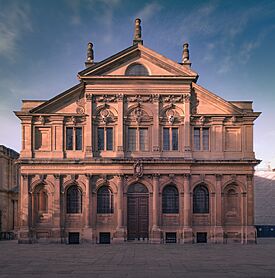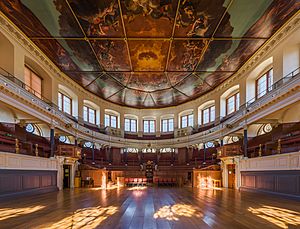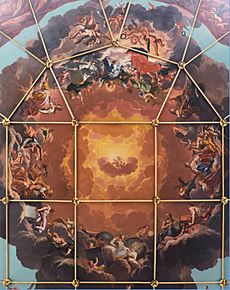Sheldonian Theatre facts for kids
Quick facts for kids Sheldonian Theatre |
|
|---|---|

South façade of the Sheldonian Theatre
|
|
| Location | Broad Street, Oxford OX1 3AZ United Kingdom |
| Built | 1664–1669 |
| Architect | Christopher Wren |
| Architectural style(s) | English Baroque |
| Owner | University of Oxford |
|
Listed Building – Grade I
|
|
| Official name: The Sheldonian Theatre | |
| Designated | 12 January 1954 |
| Reference no. | 1047350 |
| Lua error in Module:Location_map at line 420: attempt to index field 'wikibase' (a nil value). | |
The Sheldonian Theatre is a famous building in the heart of Oxford, England. It was built between 1664 and 1669. The famous architect Christopher Wren designed it for the University of Oxford. The theatre is named after Gilbert Sheldon, who was a very important person at the university and helped pay for almost all of its construction. Today, the Sheldonian Theatre is used for many things, like music concerts, interesting talks, and important university events such as graduation ceremonies. Before 2015, plays were not usually performed here. However, in 2015, the Christ Church Dramatic Society put on a play called The Crucible.
Contents
A Look Back at the Sheldonian's Story
The Sheldonian Theatre was one of the first big projects designed by Christopher Wren. The idea for it came from Gilbert Sheldon, who was the Archbishop of Canterbury. After a time of big changes in England, the Church of England became very important again. Because of this, Dean Fell, a leader at the university, wanted to bring back an old idea. This idea was to have a special building just for graduation and degree ceremonies.
In the past, these ceremonies were held in the University Church of St Mary the Virgin. These events often became very noisy. Dean Fell and his colleagues felt it was wrong to use a church for such loud events. They believed a separate building was needed. So, they asked Archbishop Gilbert Sheldon for his help and money.
Sheldon was very supportive. He first gave a large sum of £1,000. He also promised to find more money from others who shared his views. However, he didn't have much luck finding other donors. In the end, he paid almost the entire cost of £14,470 himself. This was a huge amount of money back then. For example, a skilled worker might earn only £2 to £4 a year.
How the Theatre Was Designed
Christopher Wren's first ideas for the Sheldonian might have included a stage like those in modern theatres. However, these plans changed. The building that was finally built looked very different from older Gothic-style buildings. Wren's son said that his father based the design on an old Roman theatre. This was the D-shaped Theatre of Marcellus, built in Rome a long, long time ago.
Old Roman theatres like the Theatre of Marcellus did not have roofs. Audiences would use temporary awnings if the weather was bad. But Oxford in the 1600s was not like ancient Rome. The Sheldonian Theatre needed a strong, permanent roof. The D-shaped roof needed to cover a space more than 70 feet (21 meters) wide. There were no wooden beams long enough to stretch across this distance. Wren did not want to use a traditional Gothic roof. Instead, he used a clever design called the "geometrical flat floor" grid. This idea was developed by an Oxford professor named John Wallis about 20 years earlier.
This special roof design used many shorter pieces of wood. These pieces were put together to form strong trusses. They were held in place by their own weight and with iron bolts and plates. This roof was so strong that for nearly 100 years, the University Press stored its books on top of it. For many years, it was the largest unsupported floor ever built.
In 1720, some experts checked the roof because people worried it might not be safe. They were very surprised and impressed by what they found. Even though it sagged a little from the heavy books, the experts said the roof was strong. They believed it would last for another one or two hundred years.
The Beautiful Ceiling Fresco
In November 2008, a four-year project to fix the ceiling painting was finished. This painting is a fresco, made of 32 oil-on-canvas panels. It was originally painted in 1670 by Robert Streater, who was a court painter for King Charles II. For the restoration, the panels were carefully taken down and cleaned. Their old backings were replaced, holes in the canvas were fixed, and old paint that had been added later was removed. The painting tells a story. It shows Truth coming down to help the Arts and Sciences. It also shows ignorance being chased away from the university.
Recent Events
In May 2024, the Sheldonian Theatre was a key location for student protests at Oxford University. Students gathered there to share their demands. Later, protesters blocked the path of graduation ceremonies happening at the theatre.
About the Building
The Sheldonian Theatre has a noticeable eight-sided dome, called a cupola, in the middle of its roof. Visitors can go up a staircase to this dome. The cupola has large windows on all sides. From here, you can see amazing views across the center of Oxford.
The theatre is used for many different events. These include music concerts, lectures (like the yearly Romanes Lecture), and conferences. It also hosts various university ceremonies, such as graduation and matriculation (when new students officially join the university). In 1733, the famous composer Handel conducted the first performance of his third oratorio Athalia here. Today, local groups often perform at the theatre. These include the Oxford Philomusica and the band Stornoway. Stornoway was the first pop band to play in the theatre. They performed there in 2009 for their first single launch and again in 2014 for their third album launch.
The building can hold between 800 and 1000 people. It is located next to Broad Street, on the grounds of part of the Bodleian Library. To the left of the front entrance is the Clarendon Building. To the right is the Old Ashmolean Building. Behind the Sheldonian Theatre is the Divinity School.
The Sheldonian Theatre is a Grade I listed building. This means it is a very important historic building. It was first added to the list on January 12, 1954.
The theatre is an important setting in Max Beerbohm's 1911 novel Zuleika Dobson. It was also used to represent Harvard University in the 1980 film Heaven's Gate.
Images for kids
See also
 In Spanish: Teatro Sheldonian para niños
In Spanish: Teatro Sheldonian para niños
- Holywell Music Room
- Oxford Bach Choir
- Oxford University Big Band
- Oxford Philomusica
- Stornoway (band)







